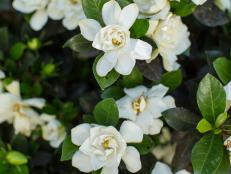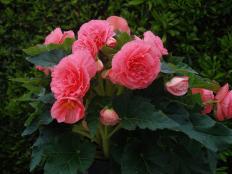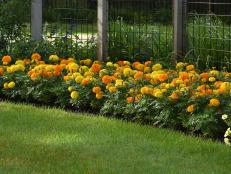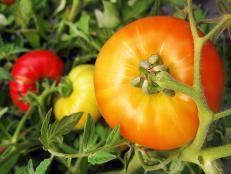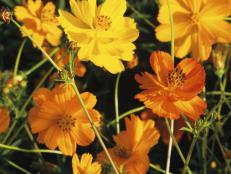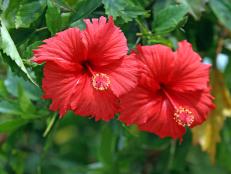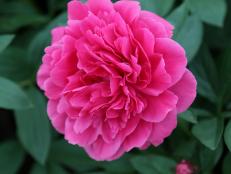How to Plant, Grow and Care for Poppy Flowers
An iconic flower, there are actually several types of poppies. Get expert tips and advice for growing and harvesting them all.
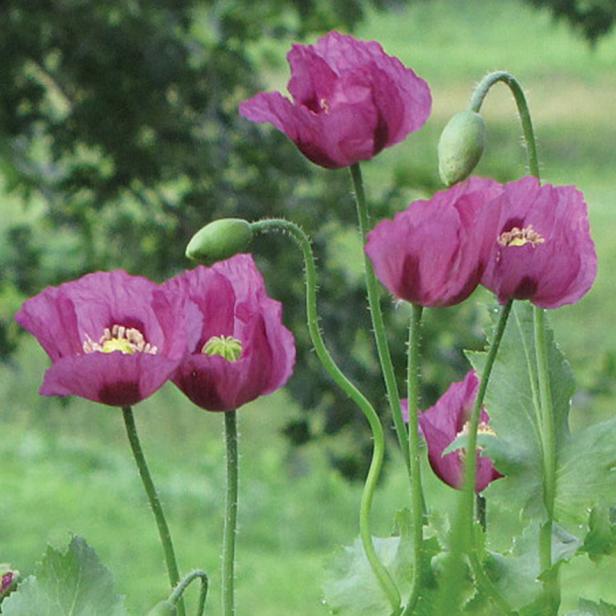
Courtesy of Seed Savers Exchange
There are many types of poppies, including Oriental, Iceland, California, Shirley, and Breadseed poppies. These Breadseed poppies are the variety 'Hungarian Blue,' known for its rich, velvety purple color. Breadseed poppies make the seeds that are used for baking. This type is also known as Opium poppy and all parts of the plant are toxic when ingested except the seeds.

When cool nights linger to meet spring’s lengthening days, poppies leap to life. Watching a poppy bud crack open to unfurl a crinkled bloom is a wondrous springtime sight. Their upturned faces dance like balloons in the breeze, beckoning the bees with pollen.
Poppies require full sun and well-draining soil. With suitable species available to hardiness zones 2-10, gardeners across the map have the opportunity to enjoy poppies. They thrive in the cooler conditions of late winter to early summer, blooming mainly between April and June, depending on the species and hardiness zone. Some poppies will bloom deeper into summer where nights remain cool.
While poppies are easy to grow once established — and self seed readily for next year’s enjoyment — the timing for seeding can be tricky and varies by zone. Keep reading to pinpoint the perfect poppy for your climate, and learn how to grow and harvest these lighthearted beauties in your garden.
Types of Poppies

Shutterstock/Nancy Kennedy
California poppies are a native flower grown for their sunny orange blooms. Hearty California poppy grows well in heat and dry soil, and readily self-sows.
California Poppy (Eschscholzia californica):
This native West Coast wildflower blankets the landscape with its golden cups and feathery, blue-green leaves. A low-growing, self-sowing flower, California poppies are a lively addition to an ornamental border, xeriscape, rock garden or wildflower meadow. California poppies are the most heat-tolerant of those featured, although they prefer dry heat with cool nights rather than persistent, humid heat. If grown in rich garden soil, more vigorous neighbors may outcompete the California poppy. However, if seeded into sandy, south-facing sites, their particular strengths will allow them to thrive where other species may wilt. California poppies must be sown in place. While shorter and more delicate than other poppy species, silky-petaled California poppies can be used as a cut flower if snipped before the bloom is fully open.
Notable varieties: California Golden, Thai Silk, Strawberry Fields
Hardiness zone: 3-10 (short-lived perennial to zones 8-10, hardy annual in zones 3-7)
Bloom Time: Late spring in southern zones; spring into summer in milder zones; may experience dormancy in high heat and return with cooler temperatures.
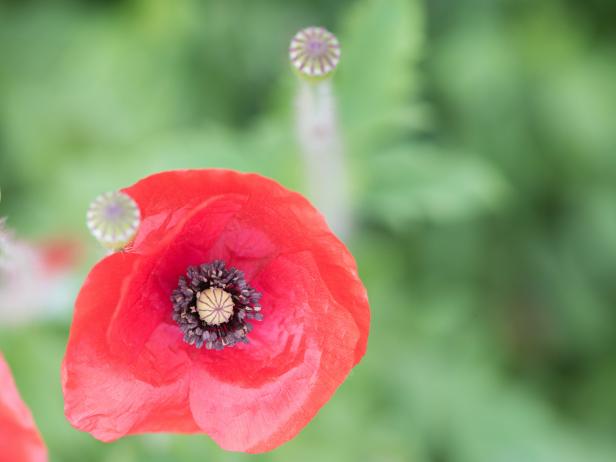
Shutterstock/May_Chanikran
Shirley poppies are the classic red poppy that many people think of when picturing poppies. Endowed with meaning, in Europe, particularly England, they're symbolic of remembrance and peace.
Shirley Poppy aka Corn, Common, or Flanders Poppy (Papaver rhoeas):
Conjuring iconic images of open fields dotted with their lipstick hue, these classic poppies exude nostalgia and romance. They have also held powerful symbolism since World War I as an emblem of remembrance and hope for peace. Beyond the well-known red variety, the painterly palette of shades found in newer cultivars is worth exploring, including almost iridescent mauve, merlot, blush and lavender. Shirley poppies can be sown successively in spring for summer blooms in zones where nights remain cool. This variety prefers direct seeding, but transplanting is possible.
Notable varieties: American Legion, Mother of Pearl, Angel’s Choir, Amazing Grey, Pandora
Hardiness zone: 3-9
Bloom time: April-June (potentially later in cooler zones)
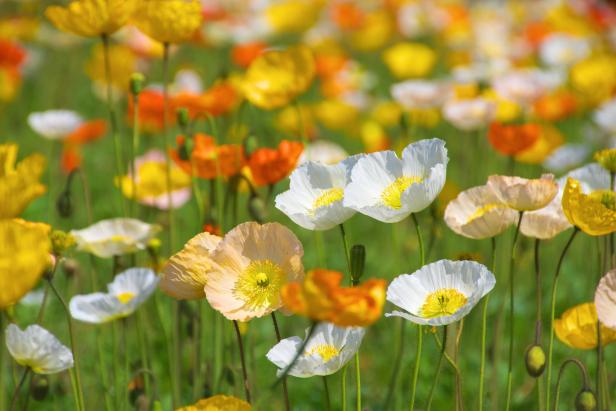
shutterstock/Inmt24
Iceland poppies have frilly edges that make them darlings of florists everywhere.
Iceland Poppy (Papaver nudicale):
A northern species that thrives in early spring, these cheerful blooms atop whimsically curved, fuzzy stems have especially vibrant personalities. Iceland poppies are wildly popular with florists and are available in a widening color palette including white, orange, yellow, peach and champagne.
Germination of Iceland poppy indoors and out can be tricky and inconsistent, particularly in the South. Pre-chill seeds in the freezer to replicate a cold dormancy period. Plugs are increasingly available to cut flower growers — a great option if starting seeds proves difficult. Iceland poppies are more amenable to transplanting than others in the Papaver family, but direct seeding is still preferred.
Notable varieties: Champagne Bubbles series, Sherbet mix, Colibri
Hardiness zone: 2-8 (may persist as a perennial in northern zones)
Bloom time: March-May (or earlier if tunnel-grown)

Bright orange-red is the go-to color of Oriental poppies. Their black centers are just as striking, if not more so, than the petals.
Oriental Poppy (Papaver orientale):
A perennial where conditions permit, Oriental poppies are a fantastic choice for returning, early spring color. While most commonly found in a striking orange-red, Oriental poppies also bloom in plum, salmon and white, often with artful black splotches on the inner petals. Oriental poppies should not be transplanted unless purchasing young plugs; bare root and larger potted plants are available but not recommended. Flowers bloom in late spring or early summer for a fleeting average of 10-14 days (a much shorter window than other poppy types). Not recommended for southern zones.
Notable varieties: Helen Elizabeth, Royal Wedding, Harlem, Brilliant
Hardiness zone: 3-7 (they may not persist as perennials in zone 7 if winters are warm, but they self seed easily and can be treated as hardy annuals)
Bloom time: Late spring or early summer (for a short period of a couple weeks)
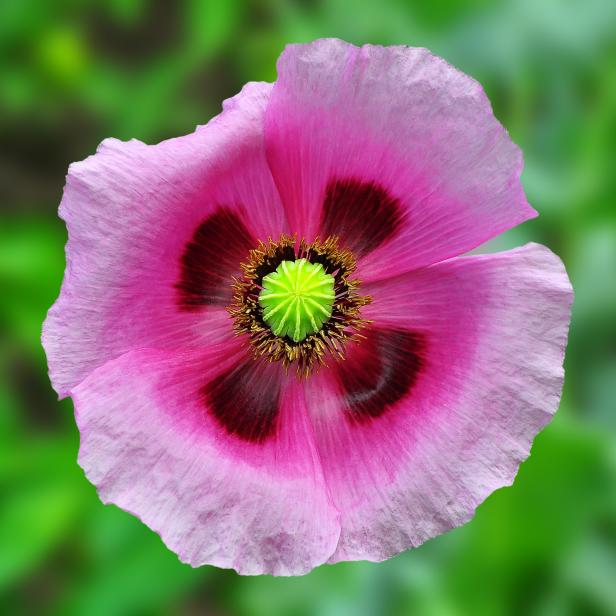
iStock/MaksymGolovinov
Breadseed, or Opium, poppies come in a variety of colors and are grown for their beautiful blooms as well as their pods, which you can see below in this article.
Breadseed or Opium Poppy (Papaver somniferum):
The lofty, dramatic blooms of Breadseed poppies are the easiest for most home gardeners to master — even in the warmer regions. Unlike Shirley, Oriental, and Iceland poppies, Breadseed poppy stems are sturdy and smooth rather than hairy and delicate. They don’t hold up well in a vase, but they produce large, rattle-like seed pods that can be used ornamentally (either fresh or dried) or saved for next year’s planting. Breadseed is also the best species for culinary poppy seed collection. This species resents transplanting, but germinates readily in fall or early spring and enthusiastically self-sows for encore performances.
Notable varieties: Lauren’s Grape, Peony Poppy, Pepperbox, Giant Rattle
Hardiness zone: 3-8
Bloom time: Late spring to early summer
How to Plant Poppies
Direct Seeding Poppies in the Garden
Direct seeding is the recommended method for planting poppies. Their roots dislike disturbance, and their seeds prefer a period of exposure to cold before germination. To start poppies from seed, simply sprinkle the seeds evenly over a smooth raked garden bed and water gently. Because poppy seeds are tiny, it can be tricky to see where you’ve already sprinkled them; mixing the seeds with a little sand can help ensure they are evenly distributed.
All poppies require light to germinate, so don’t cover them entirely with soil. Instead, press them into the surface of the soil lightly to ensure even seed-to-soil contact. Birds are known to snack on the scattered seeds; blanketing your freshly seeded bed in a lightweight row cover or sheet helps to keep birds at bay and retain consistent moisture until germination.
In zones 8-10, only fall seeding is recommended. In zones 3-7, fall seeding (October or November) is ideal, but late winter and early spring successions are possible for Shirley, Breadseed and California poppies. When seeding in fall, your poppies will overwinter at seedling size and then grow rapidly when weather warms in spring. Where summer nights remain cool, multiple spring sowings can be made for blooms deeper into summer.
Starting Poppy Seeds Indoors
When starting poppies indoors for transplanting, remember that they need cool temperatures and light to germinate. There’s no need for a heat mat to start poppies. Surface-sow poppy seeds in trays filled with a moist seed-starting soil mix; sprinkle a couple seeds in each cell, press them gently into the soil’s surface, and bottom water or gently mist to keep the soil evenly moist. A fine sprinkling of vermiculite over the seeds can help retain moisture without blocking light.
If multiple seeds germinate, thin to one seedling per cell. After more than 50 percent of the seeds have sprouted, move the tray under a grow light and monitor their development. Watering every couple weeks with a diluted seaweed solution is a helpful boost for young seedlings. When the starts have two to three sets of true leaves, they are ready to be gradually introduced to the elements through “hardening off”: move the tray outdoors for a couple hours in the shade the first day, increasing the time and sun exposure a bit each day. After a week or two, your seedlings will be robust enough for transplanting.
Seedlings should be transplanted in autumn or early spring. Read your seed packet to determine how many weeks in advance of planting you’ll need to sow seeds indoors. For example, if your poppies require eight weeks from seeding to planting, and you aim to transplant in early March, you’ll need to seed your poppies indoors around the first of January. Of the poppies mentioned, Iceland and Shirley poppies are best suited to transplanting.
Transplanting Poppies
Because poppies dislike transplanting, it is essential to go about it gently, disrupting the roots as little as possible. Ensure that plants are properly hardened off and water well before transplanting. Aim to plant on an overcast day (light rain is especially helpful). Prepare a bed in the garden that drains very well and receives full sun. While it can be counterintuitive to plant during cold weather, poppies prefer cool nights throughout their life cycle, so they should be planted in early spring (or late fall in the South). A floating row cover or caterpillar tunnel helps maintain consistent temperatures and moisture, but is not required for success with poppies.
To transplant, create a small divot in the soil large enough for the root ball, and tuck your poppy seedling into the loose soil. Gently fill the soil back in around the roots, being careful not to bury the leaves. The first set of true leaves should sit just above soil level. Use your hands to press the soil down around the base of the plant, helping the roots take hold of the soil. Water gently with your hose’s shower setting.
If you’re growing poppies for cut flower production, you may consider purchasing plugs that have been raised in a greenhouse under ideal conditions. The healthiest seedlings help ensure the greatest transplanting success and the best flower yields.
Growing Poppies in Pots
With thoughtful variety selection and proper timing, poppies can be a beautiful addition to your container garden. Seeds can be surface-sown in pots on a sunny porch in late fall, winter or very early spring, depending on your zone (see direct seeding instructions above). While waiting for seeds to germinate, the mist setting on a garden hose is the best way to water, so seeds don’t wash off undetected. Keep in mind as your poppies grow that potting soil dries out more quickly than garden soil, so check for moisture regularly. The best varieties for containers are the most compact: California poppy, Iceland poppy, Oriental poppy, or Shirley poppy. Breadseed poppies are too large for most containers.
How to Care for Poppies
Fertilizing Poppies
Poppies (especially California) have relatively low fertility requirements. If your soil is depleted, the addition of a layer of compost or leaf mold is beneficial; healthy microbial activity in the soil helps plants develop strong root systems and access nutrients more readily.
If your soil is rich in nitrogen and low in phosphorus, you may observe abundant leafy growth and lackluster blooms; in this case, applying an organic phosphorus amendment may be beneficial. Performing a soil test a season or two prior to planting can help you pinpoint any deficiencies, or make adjustments to your garden soil’s pH, to ensure it is a hospitable home for flowers.
Thinning Poppies
After direct-sowing poppies, you may find lots of seedlings bunched closely together. While poppies are accustomed to blooming wildly and can tolerate crowding, you may increase your flower yields by thinning the seedlings. To thin poppies, simply use your fingers to gently remove extraneous seedlings (or snip them at the base) so that you have one strong seedling about every 3-8 inches (closer for Shirley or Iceland poppies, further for Breadseed or Oriental poppies). There is no need to thin California poppies.
Weeding Poppies
Check your poppy bed regularly to remove weeds, especially when plants are young and in danger of being out-competed. If planted in rows, a hoe can be used to eliminate young, just-germinated weeds before they begin to challenge poppies for resources. (A collinear or scuffle hoe is an ergonomic option.) Once poppies are established, their lush and low foliage helps to suppress weeds.
Overwintering Poppies
While poppies are content with cold, you may cover them with a floating row cover or caterpillar tunnel, especially during hard freezes, to avoid damage. Covers also help keep temperature and moisture levels more consistent during volatile weather, which aids in healthy winter growth. Shirley, Breadseed, and California poppies are more sensitive to cold damage than Iceland or Oriental poppies. For farmers, overwintering in a tunnel or greenhouse is recommended for cold season crops of Iceland poppy, as severe cold and storms can damage market viability of delicate buds and flowers.
Pests and Disease
Keep an eye out for fungal diseases like Southern blight in wet spring conditions. Affected plants will show crown rot and need to be removed. Well-draining soil helps keep fungal issues at bay. Proper spacing at planting time also ensures plants have ample air flow, which is another key preventative measure for fungal disease.
Deadheading
As long as poppies haven’t fully set seed (and weather conditions remain ideal), they will continue to bloom. To encourage a lengthy display of flowers, deadhead poppies by removing spent blooms. Enjoying poppies as cut flowers also encourages regeneration, especially for Shirley and Iceland types. Don’t be shy with the snips — cutting helps plants bloom abundantly.
How to Harvest Poppies

Wildcraft Flowers
Harvesting Poppies as Cut Flowers
A darling of designers everywhere, poppies lend playful beauty to flower arrangements but require thoughtful harvest and post-harvest handling to ensure adequate vase life. Poppies should be cut at the cracked bud stage: when the bud is just starting to split open, revealing a sliver of color through the fuzzy green sepals. At this stage, the flower will continue to open after it is cut, and you may enjoy five to seven days of vase life.
Upon harvesting, cauterizing the cut ends of poppy stems over a flame, or scalding by dipping them into boiling water, are helpful strategies for extending their vitality. If growing to sell, poppies should be stored in a cooler. At home, it is best to place cut flowers in a cool area out of direct sunlight, and ensure the water is clean.
Harvesting Poppy Seeds and Pods
At the end of the poppy’s life cycle, it will form seed pods that gradually fade from green to brown. When you see brown pods dotting your poppy bed, it’s time to harvest seeds and pods. Breadseed poppy is the ideal type to harvest for tasty culinary seeds and large, round ornamental pods, which are fun to use in home decor and beloved by florists. Other poppies produce much smaller pods, which are lovely but less dramatic.

iStock/rootstocks
Breadseed poppy pods needs to stay on the plant until fully dry in order to harvest the seed for culinary use.
If your goal is to save seeds for planting, select an heirloom or open-pollinated variety to ensure next season’s blooms exhibit the same charming qualities. Seeds of F-1 hybrids are unlikely to bloom true-to-type from saved seed, so hybrid seed must be purchased annually.
To harvest poppy pods, cut stems that are fully browned; you’ll also see tiny openings along the crown of each pod where seed is released. Turn the gathered pods upside down in a bucket, and leave them in the sun for several days to hasten drying and let the seeds drop. Each day, shake the pods by the stems to release more seeds. It is important to repeat this step to ensure the pods don’t make a mess in your home — it’s surprising how much seed they carry. You can see this process in a video by gardener and poppy grower Brie Arthur.
As poppy seeds collect in the bottom of the bucket, transfer them into airtight containers and store in the refrigerator (labeled with the variety and harvest date) for baking projects and planting next season.
Design Tips for Poppies
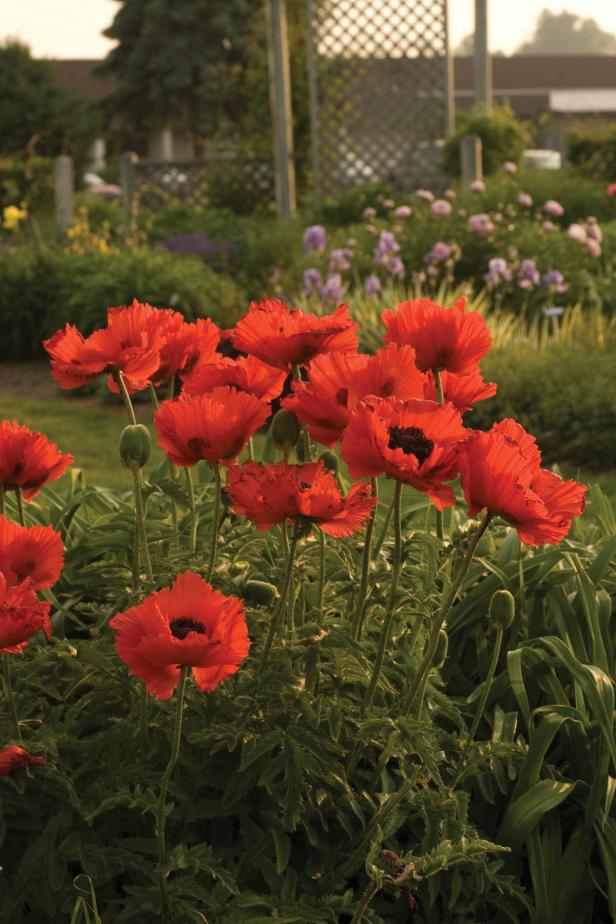
PerennialResource.com
In this garden, 'Flamenco Dancer' Oriental poppy unfurls 4- to 6-inch-wide red blossoms with a deep black center in late spring to early summer. Poppies steal the show when they’re in full bloom, but later, plants go dormant. Tuck other perennials around these bloomers to avoid bare spots in the garden. Oriental poppies form long taproots that resemble white carrots. Dividing isn’t always successful and is not typically recommended.
- In the garden, grow poppies alongside other spring-blooming hardy annuals like larkspur, bachelor’s buttons and snapdragons for a classic English cottage garden look.
- For a fun, minimalist floral design, try arranging poppy stems at varied heights in a low bowl equipped with a flower frog (also called a kenzan), playing with asymmetry and negative space.
- At the holidays, spray painting dried poppy pods in metallic shades lends festive focal points to wreaths, garlands and centerpieces.
- Beyond baking, poppy seeds have decorative and delicious potential in the kitchen. Try sprinkling them into salads or over roasted root vegetables for crunch. The black contrast is especially interesting against light-colored vegetables like cucumbers, Japanese turnips, and radishes.







